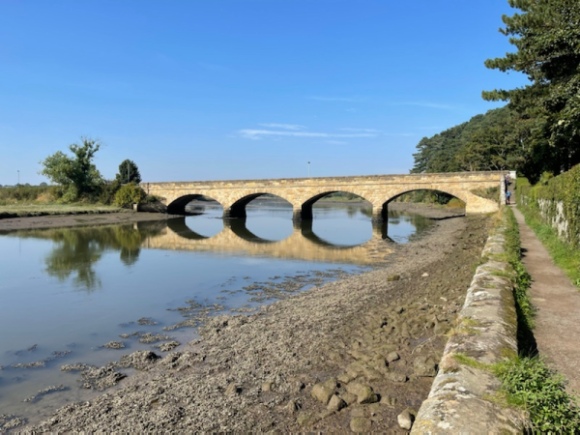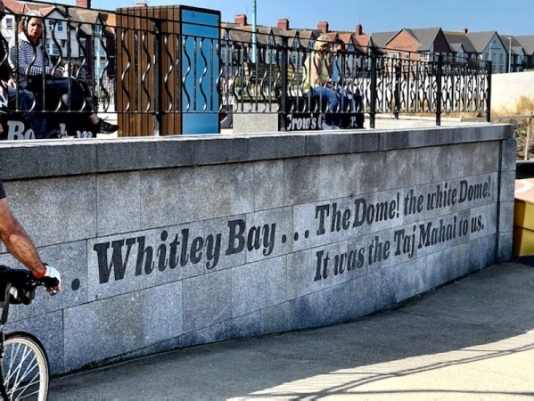
Some experiences are tiny and subtle; you don’t expect to remember them. But, days after, I was still thinking about that line of writing on the wall, in the last of the summer sunshine…
I’m a north-west lad; deeply Lancashire in my roots, though well-travelled from a business perspective. But one of my favourite parts of the UK is the North-East coast, from Whitby all the way up to Scotland, most of it in Northumberland.
This land of history and mystery used to be its own kingdom. To my mind, there is still a sense of the otherness in its hills and perfect beaches – and the people are friendly and usually welcoming.


We were spending a few days in Almmouth, that harmonic delight of estuary village meeting sea; en-route to a reunion in Edinburgh.

The oldest of the Alnmouth bridges crosses the River Aln to give the village its main access to the mainline East Coast railway station (Edinburgh in 60 mins), and the beautiful ancient town of Alnwick, ancestral home of the Percy family, who kept out the marauding Scots… Say it quietly, a good number of my cousins are Scottish.
As we often do on these trips, we were catching up with a diverse group of people, dotted along our route, including Cathy, a long-standing friend of my wife, Bernie, from the time they both worked in Bournemouth.
A few years ago, Cathy, now approaching retirement from the NHS, relocated to Whitley Bay, north of Newcastle. She had always wanted to live by the sea, and settled in Weymouth for a while, but found it too far from other places she needed to be.
Then she found her eldest son was planning to move in Teignmouth, just north of Newcastle, where he had been at university. Like his mum, he was attracted to that stretched of what was the Northumberland coast.
Cathy had a limited budget, but was delighted to discover that nearby Whitley Bay was not only affordable, but undergoing a resurgence and considerable ‘gentrification’. Formerly the haunt of the worst kind of drug dealers, facsimiles of whom seemed to feature in the ever-popular Vera detective series, it now teems with individual boutiques, quality cafes and restaurants, and coffee shops.
Locals say Whitley Bay is now safe and prosperous, yet hasn’t lost it’s common touch…
After refreshments in her sea-facing garden, Cathy took us on a guided tour of the promenade and resurgent town – the last stop on the northern leg of the Newcastle Metro line.

For a while we alternated descending and climbing back up the various sections of the expansive promenade. The sea is a long way below this section of coast road, and I wondered whether my iPhone camera would do anything useful at that distance?

After about 30 mins of walking, it was obvious that we were approaching the centre of town. Two things were of immediate interest to my photographer’s eye: a giant white building looking like a Moorish palace; and a wonderful view down to the beach, framed by curving stone walls.

Spanish City – the large white ‘palace’ – used to be the main tourist attraction of Whitley Bay. It was built 108 years ago as a ‘resort within a resort’, and offered cafes, restaurants, entertainment and a set of rides for the young and the young in heart. For the sixteen years prior to 2018, it stood derelict, until being restored and refurbished.
In July, 2021, the listed ‘Dome’ was reborn and re-opened by the local council after a £10million restoration, which included contributions of £3.47m from the Heritage Lottery Fund and a £2.5m Coastal Communities grant. It’s never looked back.
Cathy announced it was time for an ice-cream. There was a chorus of approval, especially when she crossed the coast road at speed and installed herself at the back of a short queue outside the famous Di Meo ice cream parlour. When we caught up with her, she explained that the queue was normally fifteen people deep, and she’d rushed to take advantage of this astonishingly smaller one – give it was one of the finest days of the year.
While she was queueing, I strolled quickly back to try the possible photo I’d seen. Two women were talking across a gap on the edge of a set of steep downward steps. Beyond was a panoramic view across the beaches and sea towards the distant St Mary’s lighthouse. Even in the bright sunlight of a pristine September day, it didn’t look as emotionally warm as it felt; so I took the shot with a view to editing it in a new (free) App I’d been recommended called Snapseed, made by Google.

That done (which was the work of a minute only) I crossed back over the road, just in time to collect my ice cream. We meandered slowly back, with Cathy telling the story of how the original Spanish City was etched into the memories of generations of both locals and visitors. She said there had been a famous quote, but couldn’t remember it.

Later, I remembered that I had taken a few random shots of the promenade’s slope near the ‘Dome’. One of them had Cathy’s quote. It reads:
“Whitley Bay… The Dome! the white Dome. It was the Taj Mahal to us…”
Some would laugh at it, but I thought it was a beautiful sentiment. Bolton didn’t have much in the way of glamour. But I remember the sheer sense of sophistication going into Bolton’s Navada roller skating rink as a child. I was entering a new world; and what the people of the old Whitley Bay felt about their dome must have been the same.

Now the people of Whitley Bay had their dome back, renewed and whole. It was a lesson in what we all experience – the familiarity of what we’ve grown used to versus the fading through time of what was once great. The ‘Spanish City’ had been wonderfully conceived, over a century ago, and its original vision had miraculously survived the inevitable physical decline.
The right energy and determination brought it back, justifying the sincere words on the curving wall.
My story ends there… apart from the editing I did that evening on the iPhone, using Snapseed to transform that view.

Above is the result: a picture more in tune with what I felt about the two women, the ornate steps, the sunny beach far below, filled with happy people in what was probably the last really hot day of 2021.
And in the distance the white St Mary’s lighthouse, surely one of the most beautiful symbols we have.
©Stephen Tanham 2021
Stephen Tanham is a Director of the Silent Eye, a journey through the forest of personality to the dawn of Being.
http://www.thesilenteye.co.uk and http://www.suningemini.blog
